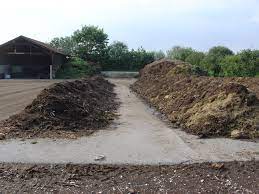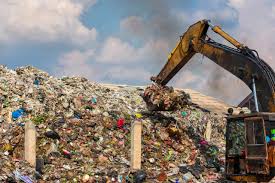Composting is one of the options for treatment of solid waste. In composting process the organic matter breaks down under bacterial action resulting in the formation of humus like material called compost.
The value of compost as manure depends on the quantity and quality of feed materials poured into the compost pit. Composting is carried out in two ways:
- Aerobically (in presence of oxygen) and
- Anaerobic ally (in absence of oxygen).
During aerobic composting, aerobic micro – organisms oxidizes organic compounds in the solid waste to carbon dioxide, nitrite and nitrate. The carbon from organic compounds is used as a source of energy while nitrogen is recycled. Due to exothermic reactions, temperature of the mass rises.
During anaerobic process, the anaerobic micro-organisms, while metabolizing the nutrients, break down the organic compounds through a process of reduction. A very small amount of energy is released during the process and the temperature of the composting mass does not raise much.
Read Also: How to Develop an Effective Waste Management Strategy
The gases evolved are mainly methane and carbon dioxide. An anaerobic process is a reduction process and the final product is subjected to some minor oxidations when applied to land.
Manure from composting gives better yield to a farmer and it is also environment friendly. Biodegradable solid waste can be composted either in compost pit or in a Vermi compost pit. Compost pit can be underground unlined compost pit or over-ground compost – heap method or over-ground brick line compost pit. Vermi compost can be done in Vermi tank (four pit model) or Vermi-compost in sheds.
Composting of bio degradable solid waste can take place in biogas plants also. Slurry from the biogas plant can also be utilized for production of Vermi compost.
Composting (Manure Pit)
Composting is carried out in a simple manure pit or garbage pit (lined or unlined). In this process aerobic microorganisms oxidize organic compounds to carbon- dioxide and oxides of nitrogen and carbon from organic compounds is used as a source of energy, while nitrogen is recycled.
As discussed above, in the composting process, due to exothermic reactions, temperature of mass rises.
Read Also: Traditional/Crude Biomedical Waste Disposal Process
In areas/regions with higher rainfall composting in over ground heaps is advisable. The factors affecting the composting process are: (a) micro- organisms; (b) moisture, (c) temperature and (d) carbon/ nitrogen (C/N) ratio.
1. Household Level Composting
At each household, two manure pits should be dug. The size of the pit will depend upon the quantity of refuse to be disposed of per day. Each day the garbage, cattle dung, straw, plant and agriculture wastes are dumped into the manure pit. When one pit is closed the other one is used.
In 5 to 6 months time, the refuse is converted into manure, which can be used in the fields. This is the most effective and simplest method of disposal of waste for the rural households.
Cow dung can also be disposed of easily by this method. Mixing of cow dung slurry with the garbage will help greatly in converting the refuse into compost, which provides good manure.
Household level composting pits may be constructed by adopting either lined or unlined pits as described below:
- Underground Unlined Manure Pit or Garbage Pit Applicability
- Rural areas with low rainfall
- Houses with an open space of about 7 square m
- Houses with no cattle or with single cattle.
Action
House owner can make this pit with little technical know how
Description
- Dig two pits of 1m x 1m x 1m dimension
- Give a single layer of broken bricks at the bottom
- Make a ridge with the help of mud at the periphery of the pit & compact it by light ramming.
Use and Maintenance of the Pit

- Go on adding garbage from the house over the layer of bricks (only biodegradable type)
- When the garbage attains a height of about 150 mm, add dung slurry, mix it with garbage & level it
- Spread a very thin layer of soil over it (once a week) to avoid odour and fly nuisance
- Continue to add garbage everyday
- Follow the above procedure & repeat the layers till the pit is full.
- It is recommended to fill the pit up to about 300 mm above ground level
- After 3-4 days the garbage above ground settles down
- Plaster it with soil
- Leave the pit as it is for 3-6 months for maturation
- After 3-6 months take out the compost & use it in the fields
- Till the manure in the pit matures, use another pit of the same dimensions, dug at a minimum distance of 1 m from the first pit.
Limitations
Not suitable for heavy rainfall areas and rocky terrain.
Read Also: Biomedical Special Waste Management Processes
Advantages of Composting
By proper decomposition, biodegradable waste gets converted into good quality organic manure whereby waste is turned into wealth
- Prevents vector breeding and breeding of rodents
- In aerobic composting process considerable heat is generated, resulting in destruction of pathogens and weed seeds
- Insanitary conditions arising out of solid waste are removed and esthetically, environment looks neat and clean.
In conclusion, composting is the controlled aerobic decomposition of organic matter by the action of microorganisms and small invertebrates. The process is controlled by making the environmental conditions optimum for the waste decomposers to thrive.
The rate of compost formation is controlled by the composition and constituents of the materials i.e. their carbon/nitrogen (C/N) ratio, the temperature, the moisture content and the amount of air.
The C/N ratio is very important for the process to be efficient. The microorganisms require carbon as an energy source and nitrogen for the synthesis of some proteins. Moisture content greatly influences the composting process.
The microbes need the moisture to perform their metabolic functions. If the waste becomes too dry the composting is not favored. If however there is too much moisture then it is possible that it may displace the air in the compost heap depriving the organisms of oxygen and drowning them.
A high temperature is desirable for the elimination of pathogenic organisms. However, if temperatures are too high, above 75oC then the organisms necessary to complete the composting process are destroyed.
Optimum temperatures for the process are in the range of 50-60oC with the ideal being 60oC. Aeration also is a very important and the quantity of air needs to be properly controlled when composting.
If there is insufficient oxygen the aerobes will begin to die and will be replaced by anaerobes. This will slow the process, produce odors and also highly flammable methane gas. Air can be incorporated by churning the compost.

